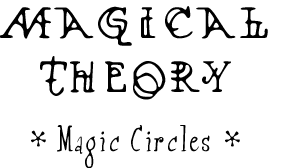 |
 Magical Ritual Methods by William Gray has an excellent chapter on magic circles in theory and practice. The view, much like that of Crowley's Magick in Theory and Practice (from whence most modern witchcraft ritual is derived) depends more on the design and intention of the operator that in the power of the circle itself. For an older look at the subject, i suggest The Book of Ceremonial Magic by A.E. Waite, for its descriptions of magic circles from the 13th to 18th centuries. These works generally consider the circle to be a protective barrier, having little to do with the magician or his work: it simple protects. Barret's work, The Magus, describes the magic circle in connection to works from this time period, but adds little to the body of information. My personal bias is towards the view that the magic circle is both a protective and concentrative device. It depends on exercizing the faculties of symbolic interaction (verbal, visual, and somatic) which acts of sorcery employ, and it thereby protects the magician in much the same way as "warm-ups" attune athletes to their sport, and protect them from muscle damage. I believe that designing the circle for protection only encourages paranoia, and that designing it for concentration only neglects the possible dangers of inattentiveness.


|
 |
 |


